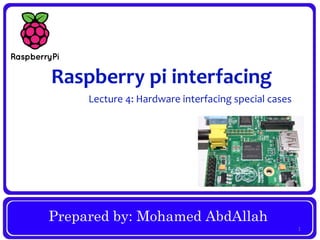
Raspberry Pi - Lecture 4 Hardware Interfacing Special Cases
- 1. Prepared by: Mohamed AbdAllah Raspberry pi interfacing Lecture 4: Hardware interfacing special cases 1
- 4. ADC What is ADC? • An analog-to-digital converter (ADC, A/D, or A to D) is a device that converts a continuous physical quantity (usually voltage) to a digital number that represents the quantity's amplitude. • The conversion involves quantization of the input, so it necessarily introduces a small amount of error. • Instead of doing a single conversion, an ADC often performs the conversions ("samples" the input) periodically. The result is a sequence of digital values that have been converted from a continuous-time and continuous-amplitude analog signal to a discrete-time and discrete- amplitude digital signal. 4
- 5. ADC What is ADC? 5
- 6. ADC ADC concepts • Sampling: is the process of taking captures of the signal each specific amount of time. • Quantization: is the process of rounding the taken value to a specific predefined constant values. • Sampling rate: the rate at which new digital values are sampled from the analog signal. • Resolution: indicates the number of discrete values it can produce over the range of analog values (ex. 8-bits ADC resolution). • Quantization error: it is the noise introduced by quantization in the ADC. It is a rounding error between the analog input voltage to the ADC and the output digitized value. The noise is non-linear and signal-dependent. 6
- 7. ADC ADC example: successive-approximation ADC • uses a comparator to successively narrow a range that contains the input voltage. At each successive step, the converter compares the input voltage to the output of an internal digital to analog converter which might represent the midpoint of a selected voltage range. At each step in this process, the approximation is stored in a successive approximation register (SAR). For example, consider an input voltage of 6.3 V and the initial range is 0 to 16 V. For the first step, the input 6.3 V is compared to 8 V (the midpoint of the 0–16 V range). The comparator reports that the input voltage is less than 8 V, so the SAR is updated to narrow the range to 0–8 V. 7
- 8. ADC ADC example: successive-approximation ADC • For the second step, the input voltage is compared to 4 V (midpoint of 0– 8). The comparator reports the input voltage is above 4 V, so the SAR is updated to reflect the input voltage is in the range 4–8 V. For the third step, the input voltage is compared with 6 V (halfway between 4 V and 8 V); the comparator reports the input voltage is greater than 6 volts, and search range becomes 6–8 V. The steps are continued until the desired resolution is reached. 8
- 10. PWM What is PWM? • Pulse-width modulation (PWM), or pulse-duration modulation (PDM), is a technique used to encode a message into a pulsing signal. It is a type of modulation. Although this modulation technique can be used to encode information for transmission, its main use is to allow the control of the power supplied to electrical devices, especially to inertial loads such as motors. • The average value of voltage (and current) fed to the load is controlled by turning the switch between supply and load on and off at a fast rate. The longer the switch is on compared to the off periods, the higher the total power supplied to the load. 10
- 11. PWM What is PWM? • The PWM switching frequency has to be much higher than what would affect the load (the device that uses the power), which is to say that the resultant waveform perceived by the load must be as smooth as possible. Typically switching has to be done several times a minute in an electric stove, 120 Hz in a lamp dimmer, from few kilohertz (kHz) to tens of kHz for a motor drive and well into the tens or hundreds of kHz in audio amplifiers and computer power supplies. 11
- 12. PWM PWM duty cycle • describes the proportion of 'on' time to the regular interval or 'period' of time, a low duty cycle corresponds to low power, because the power is off for most of the time. Duty cycle is expressed in percent, 100% being fully on. 12
- 13. PWM PWM duty cycle 13
- 15. Polling V.S Interrupt Polling • The program keeps polling on the target information until it is ready, so the program stops waiting for the required information. Interrupt • The program does any other work and when the important information is available, the program get interrupted to handle this information. 15
- 16. Mohamed AbdAllah Embedded Systems Engineer mohabdallah8@gmail.com 16
